Waving Back
Of the forces in nature, gravity is by far the weakest. For the proton and electron in a hydrogen atom, the force of gravity is about 1039 times smaller than the electrostatic force, which is what holds atoms together and determines their chemical behavior.
Yet the electrostatic force has no observable effect on the motion of planets, stars, and galaxies. That's because atoms and molecules are electrically neutral, so the electrostatic force from the electrons is canceled by an equal and opposite force from the protons. Gravity, on the other hand, is always attractive, so there is no cancellation, and gravity is the force that shapes the universe.
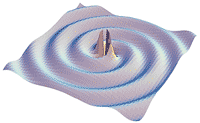
Gravitational waves emitted by a system of two collapsed stars spiraling into each other (credit: Ligo Laboratory)
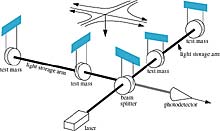
Schematic of a laser interferometer gravitational wave detector; the mirror where the arms meet is half-silvered; note that each arm has two mirrors, because in this detector two interferometers, with different lengths, operate simultaneously. (image credit: LIGO Laboratory)
Let's continue the comparison of gravity and electromagnetism. Shake a charge and it gives off electromagnetic waves, or, to say it a bit more succinctly, accelerated charges radiate. But there was no counterpart in gravity, until Einstein in his general theory of relativity predicted in 1916 that gravitational waves would be emitted by accelerated masses (see Gravitational Waves). According to Einstein, as a gravitational wave passes, the very fabric of space stretches slightly, alternately along the direction of the wave and transverse to it. Many physicists were skeptical, and Sir Arthur Eddington, who verified general relativity's prediction that starlight would be bent by the sun, is reported to have said derisively that "gravitational waves propagate at the speed of thought."
As for sources of gravitational waves, physicists concluded that the best candidates would be the rare double star composed of two neutron stars or a neutron star and a black hole. In these exotic systems, the two objects, both already collapsed to diameters of a few tens of kilometers, could approach each other very closely and exert huge gravitational forces on each other, producing correspondingly large accelerations and the emission of gravitational waves (see drawing). As the two objects merge, the frequency of rotation would increase rapidly, giving the emitted waves a characteristic amplitude and frequency signature.
Given the weakness of the gravitational force, and the fact that the spreading of the wave reduces its energy correspondingly, the amplitude observed on Earth would be incredibly small. As the wave swept by, distances would change by a factor of about 10-21, corresponding to roughly a thousandth of a proton over three kilometers.
In the 1960s and 1970s, a US physicist mounted a substantial research effort to detect gravitational waves by measuring the deformation of large aluminum cylinders. He claimed to have found them, and moreover said that they came from the center of the galaxy. As it turned out, his results were called into question, but he inspired the next generation of researchers to tackle this extraordinarily difficult experimental problem.
In the 1980s, physicists began to contemplate how new optical technologies might make it possible for a very large Michelson interferometer to measure the effect of a passing gravitational wave. A Michelson interferometer is an optical device, as shown in the drawing, with two arms and a half-silvered mirror in the center that splits the light beam into two parts, one in each arm. These beams are then reflected back, and when they recombine, they interfere. If the beams cancel—if they're 180 degrees out of phase—there is no light in the recombined beam. Should the distance one of the beams travels change, light will be detected in the combined beam, and this effect is the basis of a gravitational wave interferometer.
How large a change must be detected? Since gravitational waves distort space by a factor of about 10-21, an interferometer with arms four kilometers long—about as long as could be constructed on Earth—would produce a change in length in each arm of about 4 x 10-21 km or 4 x 10-18 km, rough a thousandth the diameter of a proton, an unimaginably small distance to measure.
Research
There are now three gravitational wave detectors in the US, two in Hanford, Washington and one in Livingston, Louisiana, which together make up the Laser Interferometer Gravitational Observatory (LIGO), a Caltech-MIT collaboration. Each detector employs an interferometer with a pair of perpendicular arms of equal length, with a state-of-the art laser as the light source.
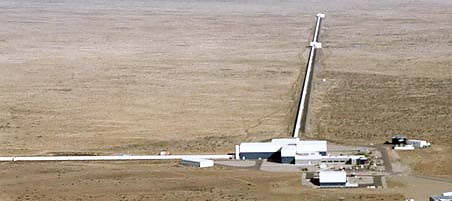
The gravitational wave detector at Hanford , Washington . The long perpendicular sheds house the two arms of the interferometer. (credit: LIGO Laboratory)
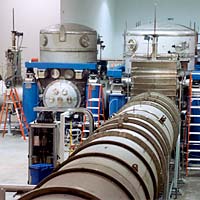
The structure that houses the interferometer beams at the Livingston , Louisiana LIGO laboratory. (credit: LIGO Laboratory)
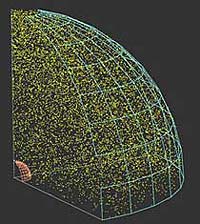
The distance that Advanced LIGO can search will be ten times that of LIGO, leading to a thousandfold increase in the volume of space (the volume of a sphere scales as the radius cubed) that can be searched (credit: LIGO Laboratory)
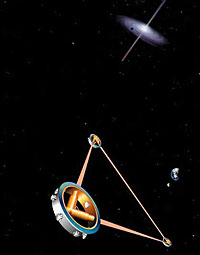
The three LISA satellites will function as a gravitational wave detector in space, with a baseline of five million kilometers. (credit: NASA/JPL)
Since the gravitational wave signal is so small, noise reduction is a major challenge. LIGO physicists isolate the interferometer mirrors from Earth movements and even compensate for them in real time by applying delicate magnetic forces to the mirrors. Moreover, the experiment is performed in a high vacuum, only about a trillionth of atmospheric pressure. Since the interferometer's arms are kilometers long, this is one of the largest evacuated spaces ever made. In all, noise is reduced by a factor of ten billion.
Seismic noise is particularly difficult to suppress because gravitational waves are predicted to share much of the frequency range of earthquakes. To help discriminate signal from noise, the two detectors in Hanford were designed with very different lengths—their perpendicular arms are 2 km and 4 km long. Since a passing gravitational wave produces a change in length proportional to the length itself, the signal from the longer detector should be twice as large as the signal from the shorter one. But a signal from an earthquake, or a local source of noise, won't scale up with the length in the same way, so seismic noise, even masquerading as a gravitational wave, can be rejected.
Likewise, the physical separation of the two laboratories helps eliminate spurious signals. The LIGO interferometers are extraordinarily sensitive—they respond to trees falling in a nearby forest and to small local earthquakes. To rule out signals from these kinds of events, the detectors in Hanford and Livingston operate simultaneously, and only signals that appear in both places at the same time are considered candidates for gravitational waves.
So far, LIGO has not detected any gravitational waves, but LIGO has met its design requirements and is a functioning observatory. The current LIGO is a prototype for Advanced LIGO, which will increase sensitivity by a factor of ten and the volume of space that can be searched for gravitational wave sources by a factor of a thousand (the searchable volume scales as the cube of the linear distance to the observed object-see drawing). Advanced LIGO should begin observations in 2013 and is expected to find gravitational waves.
Even Advanced LIGO will still be limited by the lengths of its arms and the challenges of seismic noise. Planning is underway for a gravitational wave laboratory in space, the Laser Interferometer Space Antenna (LISA), a space-based laser interferometer jointly sponsored by the European Space Agency (ESA) and NASA, originally to be launched in 2015. LISA will array three satellites in an equilateral triangle three million kilometers on a side and look for gravitational waves with frequencies less than one milli-Hertz (one thousandth of a cycle per second)—a range of frequencies inaccessible to LIGO because of seismic wave noise.
You can participate in the computer analysis of LIGO data through the Einstein@home project. If you have a high-speed internet connection, LIGO can apply your computer's unused processing power to search for signals from gravitational waves. Learn more at http://www.einsteinathome.org .
Links
University of Illinois
American Museum of Natural History
Caltech/MIT
- LIGO
- Advanced LIGO
(Don't miss the video "Einstein's Messengers" -the link is in the column of the left side of the homepage; also, see the "Advanced Ligo section.)
Einstein@Home
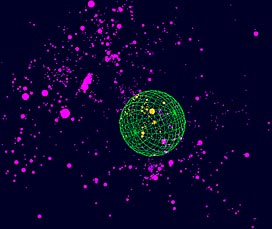
The image represents the known galaxies, and those within the sphere-about 18%--will be visible to LIGO (credit: LIGO Laboratory )














